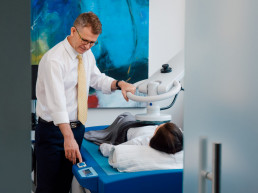Locoregional Hyperthermia
Locoregional hyperthermia is a common procedure in cancer treatment of solid tumors, for example lymph node metastases, recurrent breast tumors, skin cancer (malignant melanoma), liver metastases, etc. A water-filled silicone applicator is placed onto the skin above the tumor location. Two electrodes are sending electromagnetic waves into a tumor’s area and heat it up locally. While the temperature is rising the tumor cells get targeted “boil away” and get destroyed. We use this technique in combination with other therapies (for example radio-chemotherapy or immune therapy), which makes it even more efficient. Deciding for the efficacy is the height of the temperature on the targets area (more than 40° C), the time duration of the treatment and the direct chronological proximity to chemo- or radiotherapy. We perform the treatment on an outpatient basis and the treatment takes about one hour. When the device is turned off, the tissue will soon return to its normal temperature.
Basic understanding of the process
In the case of hyperthermia application, the body or a body region is overheated in a targeted manner. In combination with chemotherapeutic treatment or radiation, medicine promises an intensification of the therapy and an increase in the overall effect.
The origins lie in the experiences that doctors had in the past with an artificially induced fever. With chemical substances or bacteria, they ensure that the body temperature rises. However, regulating the temperature has proven to be problematic, so that experiments with artificial fever are rarely carried out today. Hyperthermia procedures, on the other hand, have proven to be much gentler and serve a comparable purpose.

Heat through Electromagnetic Waves
The procedure operates through the use of electromagnetic waves, which are targeted and precise in elevating the body’s temperature to a desired level. These electromagnetic waves can include ultrasound, radio waves, and microwaves. Heat can also be internally delivered by flushing an organ with warm fluid, often including a drug solution as part of chemotherapy.
Contrary to common belief, the goal of hyperthermia therapy is not to minimize or kill existing cancer cells through heat exposure. Achieving such an outcome would require significantly higher temperatures than what is considered safe for implementation without causing lasting harm to the body. Instead, the targeted heat makes tumor cells more sensitive to the effects of accompanying therapies. Furthermore, the increased blood flow in the tumor tissue facilitates the absorption of medications or radiation, providing a significant advantage in treatment.
